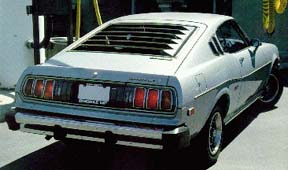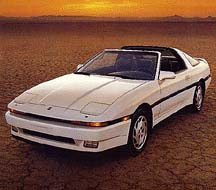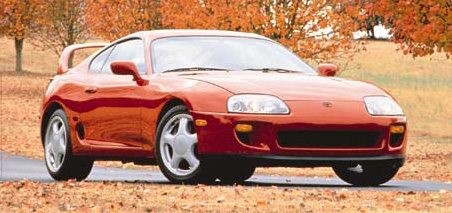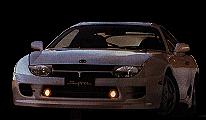The Celica & Supra Story
 The origin of the Celica dates back to 1970, when the first Celica was
introduced into the Japanese auto market. Toyota, known for its reliable,
basic transportation, felt that its position was strong enough for it to
offer its first sporty model. The Japanese economy was strengthening, and
with it, the desire to drive something more exciting than the
traditional, spartan Japanese automobile.
This new attitude by Toyota was reflected first in 1967, with the 2000GT,
a swoopy sports car built for Toyota by Yamaha. Featured in a
contemporary James Bond film, the 2000GT, with its DOHC inline-6, would
later become the inspiration for the Supra (the 2000GT name was also used on later Japanese Celicas and Supras)
. As a sidenote, the legendary Datsun 240Z appeared
in the same time frame, and may actually have been
designed on the same concept as the 2000GT.
The origin of the Celica dates back to 1970, when the first Celica was
introduced into the Japanese auto market. Toyota, known for its reliable,
basic transportation, felt that its position was strong enough for it to
offer its first sporty model. The Japanese economy was strengthening, and
with it, the desire to drive something more exciting than the
traditional, spartan Japanese automobile.
This new attitude by Toyota was reflected first in 1967, with the 2000GT,
a swoopy sports car built for Toyota by Yamaha. Featured in a
contemporary James Bond film, the 2000GT, with its DOHC inline-6, would
later become the inspiration for the Supra (the 2000GT name was also used on later Japanese Celicas and Supras)
. As a sidenote, the legendary Datsun 240Z appeared
in the same time frame, and may actually have been
designed on the same concept as the 2000GT.

In 1971, the first Celica STs arrive in America, powered by 1.9 liter
8R-C SOHC four cylinder. A four-speed manual is the only transmission
option. For '72, the larger 18R-C engine replaces the original, but the
lowered compression ratio due to new emissions requirements results in an
11-horsepower loss. A three speed automatic is now available. During the
70s, sexy styling, reminiscent of early Ford Mustangs, and an eager
four-cylinder enable the Celica, along with the Corolla, to solidify
Toyota's position in the American market. Fun to drive, and reliable to
boot, the Celica is a success.
In 1974, the GT model is introduced, with the most significant differences
being in styling and suspension. By '75, the 18RC engine gives way to the
20R, a redesigned R-series motor that displaces 2.2 liters. Motor
Trend magazine honors the 1976 Celica, naming it the "Import Car of
the Year." A newcomer to the '76 lineup is the GT Liftback, the first
hatchback Celica. With its obvious ponycar influences, these cars are generally known as the "Mustang-back Celicas."

1978 sees
a new bodystyle introduced, with wide, prominent B-pillers. Motor
Trend again honors the Celica. The next
year, the Celica Supra is introduced. The original Supra was the first
Toyota to receive EFI. Its 2.6 liter inline-6 engine produced 110
horsepower, 20 more than the GT, but the additional weight of the engine
offset much of this gain. Supra features include a lengthened chassis and
a grille reminiscent of the original 2000GT. In 1980, the Celica was again
redesigned, with a different front-end treatment. For '81, a bored-out
2.4 liter version of the 20R, the 22R, was put in the ST and GT.
The Celica Supra also received a new engine in 1981, the 5ME, the only
year of its production.
 As years go, 1982
was quite a busy one for Toyota engineers! All
Celica models were redesigned, and a new engine was available for the
Supra. The Celica received a very boxy look that is still very much
popular today, and pop-up headlights (which more lay back than pop
anywhere!) were introduced. The Supra received its own distinctive front
end (with real pop-up headlights,
and the 5ME gained another cam and became the 5MGE. Horsepower jumped
from a meager 116 to 145, and
the extra cam allowed the redline to be moved a little further up.
Independent rear suspension also became a Supra trademark. Supra
enthusiasts often refer to this car as the Mark II. The Supra is
now built as "the" Toyota performance model, and is an absolute delight to
drive!
As years go, 1982
was quite a busy one for Toyota engineers! All
Celica models were redesigned, and a new engine was available for the
Supra. The Celica received a very boxy look that is still very much
popular today, and pop-up headlights (which more lay back than pop
anywhere!) were introduced. The Supra received its own distinctive front
end (with real pop-up headlights,
and the 5ME gained another cam and became the 5MGE. Horsepower jumped
from a meager 116 to 145, and
the extra cam allowed the redline to be moved a little further up.
Independent rear suspension also became a Supra trademark. Supra
enthusiasts often refer to this car as the Mark II. The Supra is
now built as "the" Toyota performance model, and is an absolute delight to
drive!
 Late in 1982, a new Celica debuts, the GT-S, which possesses the Supra's
IRS and larger wheels. Visually, the GT-S is set apart from the GT by
its prominent flared fenders and the nicer Supra interior. Originally, the GT-S is available as a "Sport" option on the GT, and does not have a "GT-S" badge until 1984. For 1983, the new GT-S and the GT both receive the
22RE 4-cylinder, with 105 horses thanks to EFI. A slightly redesigned
front end for 1984's Celica increases the car's sex appeal dramatically,
and the cars are selling exceptionally well, even with the mandatory $2000 price increase forced on Japanese cars by the American government. The ST receives the 22RE
motor, and the Supra's motor keeps getting more power. A new, fully
electronically controlled automatic transmission (ECT) is available on
the Supra. A switch allows the driver to select normal and sport
shift modes. 1984 sees
the Supra reach 60mph in 8.6 seconds from a standstill. Minor brake light
and interior changes distinguish the '84-'85 Celica and '84-'86 Celica
Supra. Also, the first Celica convertible is offered from the factory in '85 - a company called Sunchaser had done conversions on a small scale for several years prior.
Late in 1982, a new Celica debuts, the GT-S, which possesses the Supra's
IRS and larger wheels. Visually, the GT-S is set apart from the GT by
its prominent flared fenders and the nicer Supra interior. Originally, the GT-S is available as a "Sport" option on the GT, and does not have a "GT-S" badge until 1984. For 1983, the new GT-S and the GT both receive the
22RE 4-cylinder, with 105 horses thanks to EFI. A slightly redesigned
front end for 1984's Celica increases the car's sex appeal dramatically,
and the cars are selling exceptionally well, even with the mandatory $2000 price increase forced on Japanese cars by the American government. The ST receives the 22RE
motor, and the Supra's motor keeps getting more power. A new, fully
electronically controlled automatic transmission (ECT) is available on
the Supra. A switch allows the driver to select normal and sport
shift modes. 1984 sees
the Supra reach 60mph in 8.6 seconds from a standstill. Minor brake light
and interior changes distinguish the '84-'85 Celica and '84-'86 Celica
Supra. Also, the first Celica convertible is offered from the factory in '85 - a company called Sunchaser had done conversions on a small scale for several years prior.
In 1986, Toyota decided to split the Supra off from the Celica line,
resulting in two distinct lines: the Celica and the Supra. The Celica is
new from the ground up, now being front-wheel drive. Three engines are
available, from the single cam 2S-E to the racing-bred 3S-GE. The car looks much different,
also, with a less distinct "boxiness" and a much smaller appearence.
A new engine line, the S-series, replaces the original R-series as the
Celica power plant.
 The 1986 Supra
is a carry-over from 1985, the only difference being
the added third brakelight. The third-generation Supra, labeled a 1986
and a half, is a swoopy car with obvious supercar influence, and the
new, 200hp 7MGE to back up the image.
The Supra Turbo debuts a year later, giving the Supra a lustful 230hp
to play with. Toyota decides to change the Supra's image from being
Toyota's competitor against the Camaro to that of the Corvette-killer. This policy will later
result in notable increases in performance and price. As prices increase,
sales will suffer (see 1996).
The 1986 Supra
is a carry-over from 1985, the only difference being
the added third brakelight. The third-generation Supra, labeled a 1986
and a half, is a swoopy car with obvious supercar influence, and the
new, 200hp 7MGE to back up the image.
The Supra Turbo debuts a year later, giving the Supra a lustful 230hp
to play with. Toyota decides to change the Supra's image from being
Toyota's competitor against the Camaro to that of the Corvette-killer. This policy will later
result in notable increases in performance and price. As prices increase,
sales will suffer (see 1996).
Little changes in the Celica lineup for most of the remainder of the
'80s. The car will be given slight makeovers (esp. the GTS) that will
enhance its looks.
1988 witnesses the advent of the Celica All-Trac Turbo. An all-out
wild ride, Toyota engineers gave this Celica AWD so it could handle the
turbo's force. This was done because of the need to handle the 200hp motor.
Not to mention this achieved awesome traction...
 A smooth, clean
look describes the new-for-1990 Celica. Rounded
fenders and edges make the Celica arguably the most beautiful
high-production car of the early 1990s. The 5S-FE engine, shared with the
more sedate Camry, is standard
on the GT and GT-S and produces 135hp, while the ST's 7A-FE churns
out 115hp, most of it low in the rpm range, making the car surprisingly quick off the line. The Celica looks good, is quick, and sells well.
The All-Trac Turbo (aka GT-4 to the rest of the world) is the
rowdy one in the family, with its awesome turbo power (200hp, 16-valve
3S-GTE) and full-time all-wheel drive. The All-Trac burns the 1320 in the
upper 14s...not bad for a 2.0L four-banger!o Competition begins to stiffen
against the Celica as the Probe/MX-6, Talon/Eclipse/Laser, Saturn SC2, and
Z24 crowd into the market, with the Acura Integra becoming the Celica's arch-nemesis. However, the Celica still holds a favorable
spot in a popular segment.
A smooth, clean
look describes the new-for-1990 Celica. Rounded
fenders and edges make the Celica arguably the most beautiful
high-production car of the early 1990s. The 5S-FE engine, shared with the
more sedate Camry, is standard
on the GT and GT-S and produces 135hp, while the ST's 7A-FE churns
out 115hp, most of it low in the rpm range, making the car surprisingly quick off the line. The Celica looks good, is quick, and sells well.
The All-Trac Turbo (aka GT-4 to the rest of the world) is the
rowdy one in the family, with its awesome turbo power (200hp, 16-valve
3S-GTE) and full-time all-wheel drive. The All-Trac burns the 1320 in the
upper 14s...not bad for a 2.0L four-banger!o Competition begins to stiffen
against the Celica as the Probe/MX-6, Talon/Eclipse/Laser, Saturn SC2, and
Z24 crowd into the market, with the Acura Integra becoming the Celica's arch-nemesis. However, the Celica still holds a favorable
spot in a popular segment.

The Supra is not offered in 1992, as it is redone for 1993. Its
trademark hideaway headlights are gone, but no one will miss them now that the Turbo
is now the Twin Turbo,
giving 320hp. A Borg-Warner 6-speed manual transmission is available, as
well as a 5-speed automatic. Sales are low and prices high: Twin Turbos
go for well over $50,000. Performance is also high: zero to 60mph are around 5.3 seconds and afterwards pretty much becomes a blur - prompting one famous racer to proclaim the Supra
"pure adrenaline attached to a license plate!"
 Following Toyota's four-year-cycle, the 1994 Celica assumes a new look and the GTS model is dropped. Also
gone are the hideaway headlights, eschewed in favor of four round,
individual headlights. The result is somewhat akin to the result of
breeding experiments between the Acura Integra and the Porsche 911.
Following Toyota's four-year-cycle, the 1994 Celica assumes a new look and the GTS model is dropped. Also
gone are the hideaway headlights, eschewed in favor of four round,
individual headlights. The result is somewhat akin to the result of
breeding experiments between the Acura Integra and the Porsche 911.
In 1996, there was much doubt as to the continued existence of the
Supra. Only about 40 per month were being imported into the United
States, barely double the meager 21/month to Europe. Other Japanese
legends, such as the Nissan 300ZX, Mazda RX-7, and the Dodge
Stealth had been discontinued. Whereas they had once been
affordable fun ("pocket rockets"), they had become over-optioned and
over-priced, these once-popular cars beyond the reach of those who yearned
for them. Japanese automakers learned too late that people who pay
Corvette prices have dreamed of buying one since playing with Hot
Wheels, and that their cars, while superior in many, many respects, were
largely ignored by that market. In addition, the market has turned away
from these awesome cars, towards SUVs and minivans.
 Towards
the end of 1996, however, Toyota announced that the Supra would live on. It would
lose some of its glitz, they said, becoming a more "back to the basics"
sports car, a step in the right direction. Prices have been slashed to
the upper thirties for the Twin Turbo, a drop of about $12,000. In addition,
all 1997 "15th Anniversary" Supras come standard with the huge wing formerly
reserved only for Turbo models. With the Anniversary models, it seems as if
the company has forgotten that the '79-'81 models existed for some reason or
another.
Towards
the end of 1996, however, Toyota announced that the Supra would live on. It would
lose some of its glitz, they said, becoming a more "back to the basics"
sports car, a step in the right direction. Prices have been slashed to
the upper thirties for the Twin Turbo, a drop of about $12,000. In addition,
all 1997 "15th Anniversary" Supras come standard with the huge wing formerly
reserved only for Turbo models. With the Anniversary models, it seems as if
the company has forgotten that the '79-'81 models existed for some reason or
another.
Amid much speculation and rumor, the next-generation Celica is expected to debut
sometime in 1998. Apparently, Toyota had been originally considering changing
to a front engine/rear drive format in order to make the car more performance-oriented
(as Nissan will do with the next-generation Maxima). These plans were scrapped after
research found that the largely female buyers have negative preconceptions of
rear-wheel-drive cars as dangerous and evil-handling. One rumor that refuses
to go away is that of a V6 model being included in the lineup, which would be
a break from Celica tradition, but would probably help sales. Finally,
a limited-edition, all-wheel-drive, turbo model (GT4/All-trac) is believed to
be once again in the offering. Whether or not it will make it to US shores is
another question. Here is a possibility of the '99:
 According to Toyota USA's website, it seems as though the next Celica,
which was slated for 1998, is having preproduction problems and will not be
seen until apparently April 1999. For '98, Toyota will continue making the
current Celica, although it will only be available as the GT, no STs will
be made.
Maybe this is the reason Toyota hasn't called me up yet to go behind the scenes for an exclusive test-drive of the new models (hint hint wink wink nudge nudge), so I can't tell you much more. As for speculation, I'm hoping Toyota gives us a
magical motor with variable valve-timing (VVTi), like on the Supra and GS400,
something to keep those Integras at bay. If how well a job Lexus did with the
GS400 is any indication of the enthusiast-minded cars coming from Toyota
soon, I think we'll see quite a few 1999 Celicas on the road next year!
According to Toyota USA's website, it seems as though the next Celica,
which was slated for 1998, is having preproduction problems and will not be
seen until apparently April 1999. For '98, Toyota will continue making the
current Celica, although it will only be available as the GT, no STs will
be made.
Maybe this is the reason Toyota hasn't called me up yet to go behind the scenes for an exclusive test-drive of the new models (hint hint wink wink nudge nudge), so I can't tell you much more. As for speculation, I'm hoping Toyota gives us a
magical motor with variable valve-timing (VVTi), like on the Supra and GS400,
something to keep those Integras at bay. If how well a job Lexus did with the
GS400 is any indication of the enthusiast-minded cars coming from Toyota
soon, I think we'll see quite a few 1999 Celicas on the road next year!
Feel free email OldMage if you have comments
or corrections.

Copyright 1996-98 Tom Kyle and OldMage
 The origin of the Celica dates back to 1970, when the first Celica was
introduced into the Japanese auto market. Toyota, known for its reliable,
basic transportation, felt that its position was strong enough for it to
offer its first sporty model. The Japanese economy was strengthening, and
with it, the desire to drive something more exciting than the
traditional, spartan Japanese automobile.
This new attitude by Toyota was reflected first in 1967, with the 2000GT,
a swoopy sports car built for Toyota by Yamaha. Featured in a
contemporary James Bond film, the 2000GT, with its DOHC inline-6, would
later become the inspiration for the Supra (the 2000GT name was also used on later Japanese Celicas and Supras)
. As a sidenote, the legendary Datsun 240Z appeared
in the same time frame, and may actually have been
designed on the same concept as the 2000GT.
The origin of the Celica dates back to 1970, when the first Celica was
introduced into the Japanese auto market. Toyota, known for its reliable,
basic transportation, felt that its position was strong enough for it to
offer its first sporty model. The Japanese economy was strengthening, and
with it, the desire to drive something more exciting than the
traditional, spartan Japanese automobile.
This new attitude by Toyota was reflected first in 1967, with the 2000GT,
a swoopy sports car built for Toyota by Yamaha. Featured in a
contemporary James Bond film, the 2000GT, with its DOHC inline-6, would
later become the inspiration for the Supra (the 2000GT name was also used on later Japanese Celicas and Supras)
. As a sidenote, the legendary Datsun 240Z appeared
in the same time frame, and may actually have been
designed on the same concept as the 2000GT.


 As years go, 1982
was quite a busy one for Toyota engineers! All
Celica models were redesigned, and a new engine was available for the
Supra. The Celica received a very boxy look that is still very much
popular today, and pop-up headlights (which more lay back than pop
anywhere!) were introduced. The Supra received its own distinctive front
end (with real pop-up headlights,
and the 5ME gained another cam and became the 5MGE. Horsepower jumped
from a meager 116 to 145, and
the extra cam allowed the redline to be moved a little further up.
Independent rear suspension also became a Supra trademark. Supra
enthusiasts often refer to this car as the Mark II. The Supra is
now built as "the" Toyota performance model, and is an absolute delight to
drive!
As years go, 1982
was quite a busy one for Toyota engineers! All
Celica models were redesigned, and a new engine was available for the
Supra. The Celica received a very boxy look that is still very much
popular today, and pop-up headlights (which more lay back than pop
anywhere!) were introduced. The Supra received its own distinctive front
end (with real pop-up headlights,
and the 5ME gained another cam and became the 5MGE. Horsepower jumped
from a meager 116 to 145, and
the extra cam allowed the redline to be moved a little further up.
Independent rear suspension also became a Supra trademark. Supra
enthusiasts often refer to this car as the Mark II. The Supra is
now built as "the" Toyota performance model, and is an absolute delight to
drive!
 Late in 1982, a new Celica debuts, the GT-S, which possesses the Supra's
IRS and larger wheels. Visually, the GT-S is set apart from the GT by
its prominent flared fenders and the nicer Supra interior. Originally, the GT-S is available as a "Sport" option on the GT, and does not have a "GT-S" badge until 1984. For 1983, the new GT-S and the GT both receive the
22RE 4-cylinder, with 105 horses thanks to EFI. A slightly redesigned
front end for 1984's Celica increases the car's sex appeal dramatically,
and the cars are selling exceptionally well, even with the mandatory $2000 price increase forced on Japanese cars by the American government. The ST receives the 22RE
motor, and the Supra's motor keeps getting more power. A new, fully
electronically controlled automatic transmission (ECT) is available on
the Supra. A switch allows the driver to select normal and sport
shift modes. 1984 sees
the Supra reach 60mph in 8.6 seconds from a standstill. Minor brake light
and interior changes distinguish the '84-'85 Celica and '84-'86 Celica
Supra. Also, the first Celica convertible is offered from the factory in '85 - a company called Sunchaser had done conversions on a small scale for several years prior.
Late in 1982, a new Celica debuts, the GT-S, which possesses the Supra's
IRS and larger wheels. Visually, the GT-S is set apart from the GT by
its prominent flared fenders and the nicer Supra interior. Originally, the GT-S is available as a "Sport" option on the GT, and does not have a "GT-S" badge until 1984. For 1983, the new GT-S and the GT both receive the
22RE 4-cylinder, with 105 horses thanks to EFI. A slightly redesigned
front end for 1984's Celica increases the car's sex appeal dramatically,
and the cars are selling exceptionally well, even with the mandatory $2000 price increase forced on Japanese cars by the American government. The ST receives the 22RE
motor, and the Supra's motor keeps getting more power. A new, fully
electronically controlled automatic transmission (ECT) is available on
the Supra. A switch allows the driver to select normal and sport
shift modes. 1984 sees
the Supra reach 60mph in 8.6 seconds from a standstill. Minor brake light
and interior changes distinguish the '84-'85 Celica and '84-'86 Celica
Supra. Also, the first Celica convertible is offered from the factory in '85 - a company called Sunchaser had done conversions on a small scale for several years prior.
 The 1986 Supra
is a carry-over from 1985, the only difference being
the added third brakelight. The third-generation Supra, labeled a 1986
and a half, is a swoopy car with obvious supercar influence, and the
new, 200hp 7MGE to back up the image.
The Supra Turbo debuts a year later, giving the Supra a lustful 230hp
to play with. Toyota decides to change the Supra's image from being
Toyota's competitor against the Camaro to that of the Corvette-killer. This policy will later
result in notable increases in performance and price. As prices increase,
sales will suffer (see 1996).
The 1986 Supra
is a carry-over from 1985, the only difference being
the added third brakelight. The third-generation Supra, labeled a 1986
and a half, is a swoopy car with obvious supercar influence, and the
new, 200hp 7MGE to back up the image.
The Supra Turbo debuts a year later, giving the Supra a lustful 230hp
to play with. Toyota decides to change the Supra's image from being
Toyota's competitor against the Camaro to that of the Corvette-killer. This policy will later
result in notable increases in performance and price. As prices increase,
sales will suffer (see 1996).
 A smooth, clean
look describes the new-for-1990 Celica. Rounded
fenders and edges make the Celica arguably the most beautiful
high-production car of the early 1990s. The 5S-FE engine, shared with the
more sedate Camry, is standard
on the GT and GT-S and produces 135hp, while the ST's 7A-FE churns
out 115hp, most of it low in the rpm range, making the car surprisingly quick off the line. The Celica looks good, is quick, and sells well.
The All-Trac Turbo (aka GT-4 to the rest of the world) is the
rowdy one in the family, with its awesome turbo power (200hp, 16-valve
3S-GTE) and full-time all-wheel drive. The All-Trac burns the 1320 in the
upper 14s...not bad for a 2.0L four-banger!o Competition begins to stiffen
against the Celica as the Probe/MX-6, Talon/Eclipse/Laser, Saturn SC2, and
Z24 crowd into the market, with the Acura Integra becoming the Celica's arch-nemesis. However, the Celica still holds a favorable
spot in a popular segment.
A smooth, clean
look describes the new-for-1990 Celica. Rounded
fenders and edges make the Celica arguably the most beautiful
high-production car of the early 1990s. The 5S-FE engine, shared with the
more sedate Camry, is standard
on the GT and GT-S and produces 135hp, while the ST's 7A-FE churns
out 115hp, most of it low in the rpm range, making the car surprisingly quick off the line. The Celica looks good, is quick, and sells well.
The All-Trac Turbo (aka GT-4 to the rest of the world) is the
rowdy one in the family, with its awesome turbo power (200hp, 16-valve
3S-GTE) and full-time all-wheel drive. The All-Trac burns the 1320 in the
upper 14s...not bad for a 2.0L four-banger!o Competition begins to stiffen
against the Celica as the Probe/MX-6, Talon/Eclipse/Laser, Saturn SC2, and
Z24 crowd into the market, with the Acura Integra becoming the Celica's arch-nemesis. However, the Celica still holds a favorable
spot in a popular segment.
 Following Toyota's four-year-cycle, the 1994 Celica assumes a new look and the GTS model is dropped. Also
gone are the hideaway headlights, eschewed in favor of four round,
individual headlights. The result is somewhat akin to the result of
breeding experiments between the Acura Integra and the Porsche 911.
Following Toyota's four-year-cycle, the 1994 Celica assumes a new look and the GTS model is dropped. Also
gone are the hideaway headlights, eschewed in favor of four round,
individual headlights. The result is somewhat akin to the result of
breeding experiments between the Acura Integra and the Porsche 911.
 Towards
the end of 1996, however, Toyota announced that the Supra would live on. It would
lose some of its glitz, they said, becoming a more "back to the basics"
sports car, a step in the right direction. Prices have been slashed to
the upper thirties for the Twin Turbo, a drop of about $12,000. In addition,
all 1997 "15th Anniversary" Supras come standard with the huge wing formerly
reserved only for Turbo models. With the Anniversary models, it seems as if
the company has forgotten that the '79-'81 models existed for some reason or
another.
Towards
the end of 1996, however, Toyota announced that the Supra would live on. It would
lose some of its glitz, they said, becoming a more "back to the basics"
sports car, a step in the right direction. Prices have been slashed to
the upper thirties for the Twin Turbo, a drop of about $12,000. In addition,
all 1997 "15th Anniversary" Supras come standard with the huge wing formerly
reserved only for Turbo models. With the Anniversary models, it seems as if
the company has forgotten that the '79-'81 models existed for some reason or
another.

